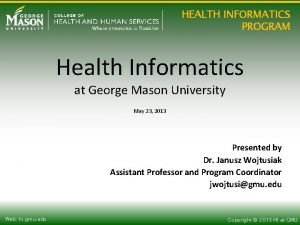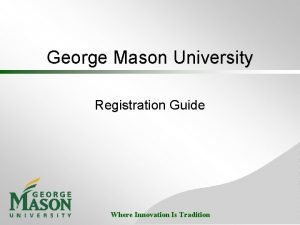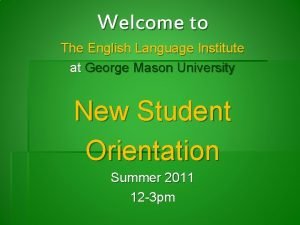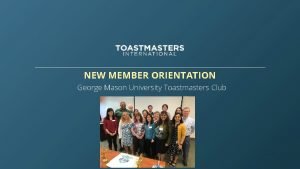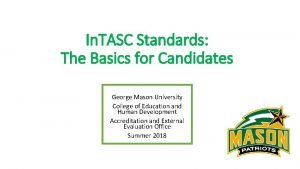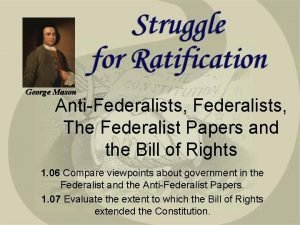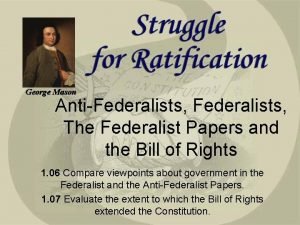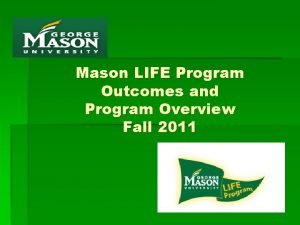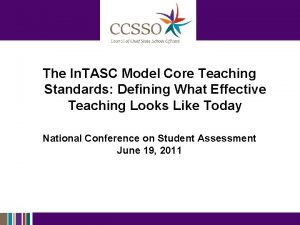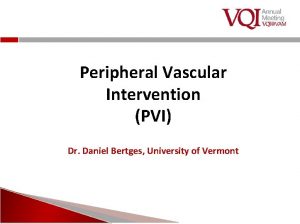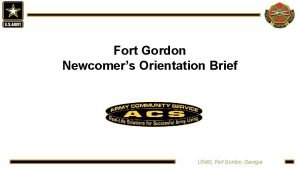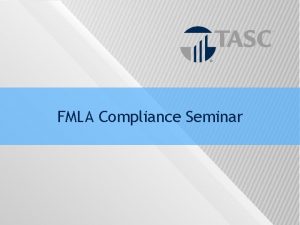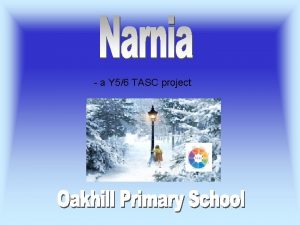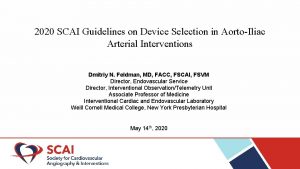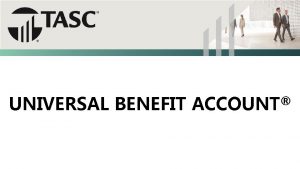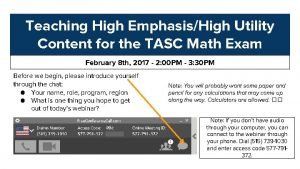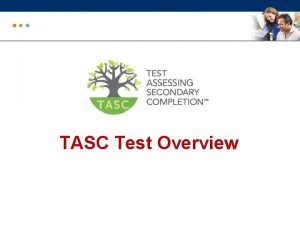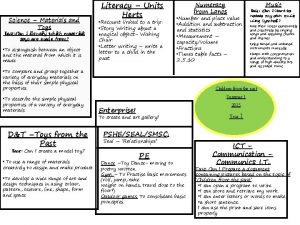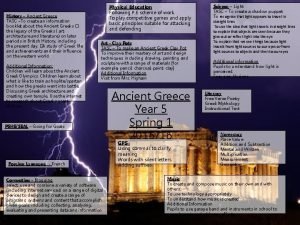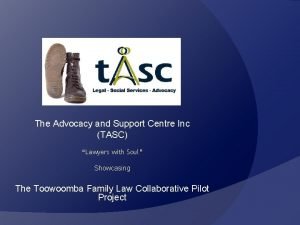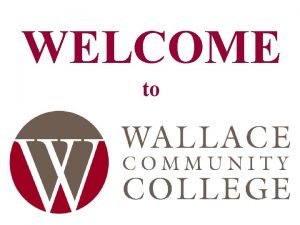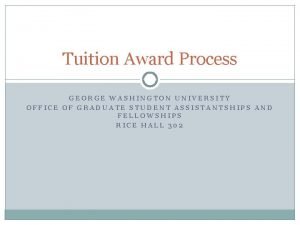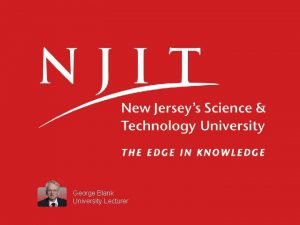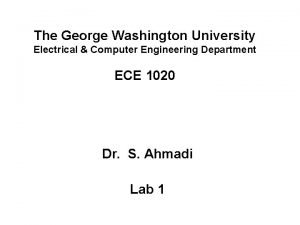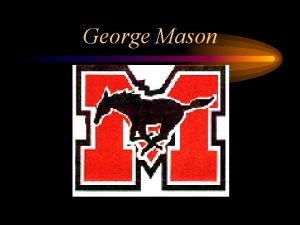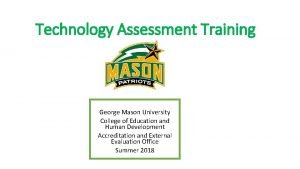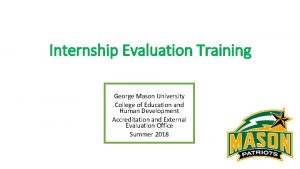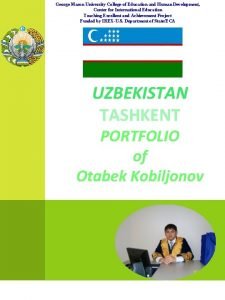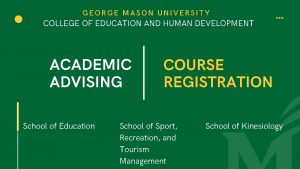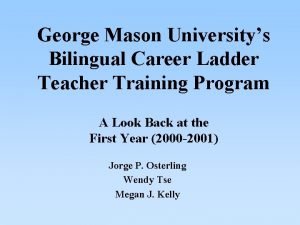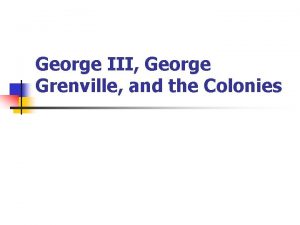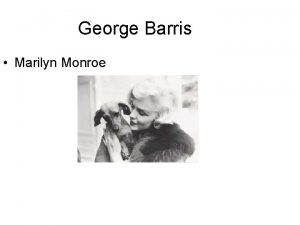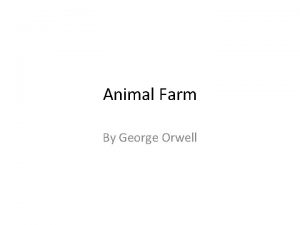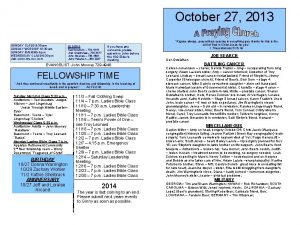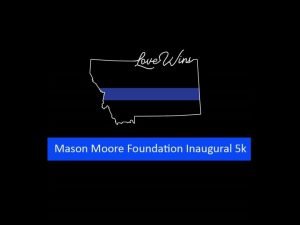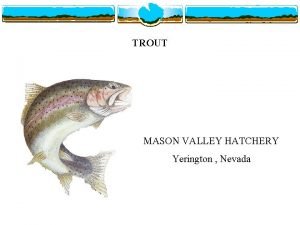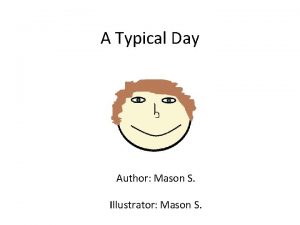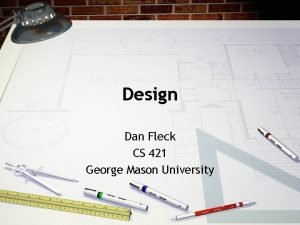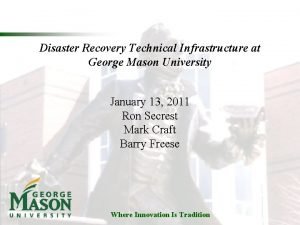In TASC Standards Training George Mason University College

































- Slides: 33

In. TASC Standards Training George Mason University College of Education and Human Development Accreditation and External Evaluation Office Summer 2018

CAEP, the accrediting group for teacher education programs, uses the In. TASC standards to assess the performance of our teacher candidates and candidates in advanced programs. For more information on CAEP and CCSSO, click below.

In. TASC’s New Vision of Teaching for Improved Student Achievement The updating of the core teaching standards was driven not only by new understandings of learners and learning but also by the new imperative that every student can and must achieve to high standards. Educators are now being held to new levels of accountability for improved student outcomes. These standards embrace this new emphasis and describe what effective teaching that leads to improved student achievement looks like. These standards promote a new paradigm for delivering education and call for a new infrastructure of support for professionals in that system. The standards are based on our best understanding of current research on teaching practice with the acknowledgement that how students learn and strategies for engaging learners are evolving more quickly than ever. The key themes that run through the updated teaching standards and how they will drive improved student learning: The In. TASC standards are assessed in multiple course assignment and are the foundation for the Internship Evaluation. (page 3, In. TASC Model Core Teaching Standards)

Accreditation: a process of self-study & external evaluation/validation The College of Education and Human Development (CEHD), as required by the Virginia Department of Education, is pursuing accreditation by the Council for the Accreditation of Educator Preparation (CAEP). CAEP Standard 1. 1 requires the use of the In. TASC Model Core Teaching Standards to assess our candidates’ performance regardless of program, level, or placement. The Interstate Teacher Assessment and Support Consortium (In. TASC) standards have been around since the early 1990 s and were originally developed specifically for NEW teachers by the Council of Chief State School Officers. The ten standards have recently been revised for use with all teachers. They were grouped into four categories and the descriptors revised to include more global, contemporary, and technology enhanced language. The four categories are: The Learner and Learning Content Instructional Practice Professional Responsibility Information used in this material was taken from Council of Chief School Officers. (2011, April). Interstate Teacher Assessment and Support Consortium (In. TASC) Model Core Teaching Standards: A Resource for State Dialogue. Washington, DC: Author.

The Learner and Learning Teaching begins with the learner. To ensure that each student learns new knowledge and skills, teachers must understand that learning and developmental patterns vary among individuals, that learners bring unique individual differences to the learning process, and that learners need supportive and safe learning environments to thrive. Effective teachers have high expectations for each and every learner and implement developmentally appropriate, challenging learning experiences within a variety of learning environments that help all learners meet high standards and reach their full potential. Teachers do this by combining a base of professional knowledge, including an understanding of how cognitive, linguistic, social, emotional, and physical development occurs, with the recognition that learners are individuals who bring differing personal and family backgrounds, skills, abilities, perspectives, talents and interests. Teachers collaborate with learners, colleagues, school leaders, families, members of the learners’ communities, and community organizations to better understand their students and maximize their learning. Teachers promote learners’ acceptance of responsibility for their own learning and collaborate with them to ensure the effective design and implementation of both self-directed and collaborative learning.

The Learner and Learning • Standard #1: Learner Development. The teacher understands how learners grow and develop, recognizing that patterns of learning and development vary individually within and across the cognitive, linguistic, social, emotional, and physical areas, and designs and implements developmentally appropriate and challenging learning experiences. • Standard #2: Learning Differences. The teacher uses understanding of individual differences and diverse cultures and communities to ensure inclusive learning environments that enable each learner to meet high standards. • Standard #3: Learning Environments. The teacher works with others to create environments that support individual and collaborative learning, and that encourage positive social interaction, active engagement in learning, and self motivation.

The Learner and Learning: Selected performance examples from In. TASC Core Teaching Standards The candidate: • demonstrates ongoing assessment to design, adapt/modify and deliver instruction to meet learner strengths and needs in each area of development. Instruction includes high expectations, respectful interactions, rigorous academic discussions, and individual and group responsibility for quality work. • creates developmentally appropriate instruction for all learners to address specific learning differences or needs. • collaborates with members of the school community to promote learner growth and development, including multiple perspectives, appropriate resources and specialized assistance to meet particular learning differences and needs, including tools of language development for making content accessible to English language learners. • builds a safe, positive learning climate of openness, mutual respect, support, and inquiry. This includes developing shared values, respect for and responsiveness to the cultural backgrounds and differing perspectives learners bring to the learning environment. • intentionally builds learner capacity to collaborate in face-to-face and virtual environments through applying effective interpersonal communication skills to extend the possibilities for learning locally and globally.

Questions related to the In. TASC Standards to ask about your candidate's work: Are there other questions YOUR program might ask that are different? Standard #1: Learner Development. • Does the candidate use research -based, knowledge, and appropriate skills and dispositions when planning developmentally appropriate learning experiences for all learners? • Does the candidate address all developmental areas when planning instruction? Standard #2: Learning Differences. • Does the candidate create learning experiences guided by the needs of individual learners, and addressing the range of learning differences and cultural and community diversity? • Does the candidate hold high standards and expectations that all learners can succeed? Standard #3: Learning Environments. • Does the candidate use knowledge of learner development and learning differences to create an environment that supports learning for all? • Does the candidate create opportunities for individual and group learning tasks that support the development of positive relationships in addition to active learning and self-motivation?

Identify Learner Development attributes assessed in YOUR program: Standard #1: Learner Development. What observable actions would a candidate display if he/she was a having an impact on learner development? In addition to the Common Assessments, where is this standard assessed in your program? Courses, field experiences, internship? • A candidate in your program would be successful at meeting Standard #1 if you observed the following: -

Identify Learner Differences attributes assessed in YOUR program: Standard #2: Learning Differences. What observable actions would a candidate display if he/she was a having an impact on addressing learner differences? In addition to the Common Assessments, where is this standard assessed in your program? Courses, field experiences, internship? • A candidate in your program would be successful at meeting Standard #2 if you observed the following: -

Identify Learning Environment attributes assessed in YOUR program: Standard #3: Learning Environments. What observable actions would a candidate display if he/she was a creating a positive learning environment? In addition to the Common Assessments, where is this standard assessed in your program? Courses, field experiences, internship? • A candidate in your program would be successful at meeting Standard #3 if you observed the following: -

Content Teachers must have a deep and flexible understanding of their content areas and be able to draw upon content knowledge as they work with learners to access information, apply knowledge in real world settings, and address meaningful issues to assure learner mastery of the content. Today’s teachers make content knowledge accessible to learners by using multiple means of communication, including digital media and information technology. They integrate cross-disciplinary skills (e. g. , critical thinking, problem solving, creativity, communication) to help learners use content to propose solutions, forge new understandings, solve problems, and imagine possibilities. Finally, teachers make content knowledge relevant to learners by connecting it to local, state, national, and global issues.

Content • Standard #4: Content Knowledge. The teacher understands the central concepts, tools of inquiry, and structures of the discipline(s) he or she teaches and creates learning experiences that make the discipline accessible and meaningful for learners to assure mastery of the content. • Standard #5: Application of Content. The teacher understands how to connect concepts and use differing perspectives to engage learners in critical thinking, creativity, and collaborative problem solving related to authentic local and global issues.

Content Selected performance examples from In. TASC Core Teaching Standards The candidate: • effectively uses multiple representations that capture key ideas in the discipline, guide learners through learning progressions, and promote learner achievement of content standards by applying methods of inquiry and standards of evidence used in the discipline. • stimulates learner reflection on prior content knowledge, links new concepts to familiar concepts, and makes connections to learners’ experiences. • encourages learners to understand, question, and analyze ideas from diverse perspectives so that they master the content. This includes recognizing learner misconceptions in a discipline that interfere with learning, and creating experiences to build accurate conceptual understanding to generate and evaluate new ideas and novel approaches, seeking inventive solutions to problems, and developing original work. • uses supplemental resources and technologies to ensure accessibility and relevance for all learners, including those in their primary language. • engages learners in applying content knowledge to real world problems through the lens of interdisciplinary themes and fosters innovation and problem solving in local and global contexts. • develops and implements projects (including those that connect content knowledge to real world problems) that guide learners in analyzing the complexities of an issue or question using perspectives from varied disciplines and cross-disciplinary skills

Questions related to the In. TASC Standards to ask about your candidate's work: Are there other questions YOUR program might ask that are different? Standard #4: Content Knowledge. • Does the candidate understand that content is taught in different ways based upon the structure of each discipline? • Does that candidate use their understanding of the learner and learning differences to make learning accessible to all and meaningful for the learners in his/her classroom? Standard #5: Application of Content. • Does the candidate use different perspectives and cross-disciplinary connections to engage learners? • Does the candidate create meaningful, authentic tasks that require critical thinking, creativity, and problem-solving of local and global issues?

Identify Content Knowledge attributes assessed in YOUR program: Standard #4: Content Knowledge. What observable actions would a candidate display if he/she was a having an impact on learner development of content knowledge? In addition to the Common Assessments, where is this standard assessed in your program? Courses, field experiences, internship? • A candidate in your program would be successful at meeting Standard #4 if you observed the following: -

Identify Content Application attributes assessed in YOUR program: Standard #5: Application of Content. What observable actions would a candidate display if he/she was a connecting concepts and using multiple perspectives to engage learners in meaningful, authentic tasks that require critical thinking, creativity, and problemsolving of local and global issues? In addition to the Common Assessments, where is this standard assessed in your program? Courses, field experiences, internship? • A candidate in your program would be successful at meeting Standard #5 if you observed the following: -

Instructional Practice Effective instructional practice requires that teachers understand integrate assessment, planning, and instructional strategies in coordinated and engaging ways. Beginning with their end or goal, teachers first identify student learning objectives and content standards and align assessments to those objectives. Teachers understand how to design, implement and interpret results from a range of formative and summative assessments. This knowledge is integrated into instructional practice so that teachers have access to information that can be used to provide immediate feedback to reinforce student learning and to modify instruction. Planning focuses on using a variety of appropriate and targeted instructional strategies to address diverse ways of learning, to incorporate new technologies to maximize and individualize learning, and to allow learners to take charge of their own learning and do it in creative ways.

Instructional Practice • Standard #6: Assessment. The teacher understands and uses multiple methods of assessment to engage learners in their own growth, to monitor learner progress, and to guide the teacher’s and learner’s decision making. • Standard #7: Planning for Instruction. The teacher plans instruction that supports every student in meeting rigorous learning goals by drawing upon knowledge of content areas, curriculum, cross-disciplinary skills, and pedagogy, as well as knowledge of learners and the community context. • Standard #8: Instructional Strategies. The teacher understands and uses a variety of instructional strategies to encourage learners to develop deep understanding of content areas and their connections, and to build skills to apply knowledge in meaningful ways.

Instructional Practice Selected performance examples from In. TASC Core Teaching Standards The candidate: • designs assessments that match learning objectives with assessment methods and minimizes sources of bias that can distort assessment results, balancing the use of formative and summative assessments. • engages learners in multiple ways of demonstrating knowledge and skill as part of the assessment process. And assists learners in identifying quality work and provides them with effective, descriptive feedback to guide their progress toward that work. • effectively uses multiple and appropriate types of assessment data to identify each student’s learning needs and to develop differentiated learning experiences, including technology tools to support assessment practice both to engage learners more fully and to assess and address learner needs. • individually and collaboratively plans how to achieve each learning goals, choosing appropriate strategies and accommodations, resources, and materials to differentiate instruction for individuals and groups of learners. Candidate collaborates with professionals with specialized expertise to jointly deliver appropriate learning experiences to meet unique learner needs. • uses appropriate strategies and resources to adapt instruction to the needs of individuals and groups of learners, continuously monitoring student learning, engaging learners in assessing their progress, and adjusting instruction in response to student learning needs. • engages all learners in developing higher order questioning skills and metacognitive processes.

Questions related to the In. TASC Standards to ask about your candidate's work: Are there other questions YOUR program might ask that are different? Standard #6: Assessment. • Does the candidate use both formative and summative assessments to monitor learner progress and guide future instruction? • Does the candidate involve the learner in tracking personal growth and planning to improve their progress? • Does the candidate use technology for assessment and tracking learner progress? Standard #7: Planning for Instruction. • Does the candidate use their knowledge of the learning and learning differences, along with an understanding of content, to plan instruction that meets the needs of all learners? • Does the candidate plan instruction that is relevant to their learners, timely/responsive to the community, and create cross-disciplinary connections? • Does the candidate plan instruction that is challenging, yet accessible for all learners? Standard #8: Instructional Strategies. • Does the candidate vary instruction based upon the needs of the learners? • Does the candidate plan instruction that actively engages learners with the content in meaningful ways?

Identify Assessment attributes assessed in YOUR program: Standard #6: Assessment. What observable actions would a candidate display if he/she was using assessment to impact on learner development? In addition to the Common Assessments, where is this standard assessed in your program? Courses, field experiences, internship? • A candidate in your program would be successful at meeting Standard #6 if you observed the following: -

Identify Planning attributes assessed in YOUR program: Standard #7: Planning for Instruction. What observable actions would a candidate display if he/she was a planning instruction to engage learners in meaningful, authentic tasks that are accessible to all learners? In addition to the Common Assessments, where is this standard assessed in your program? Courses, field experiences, internship? • A candidate in your program would be successful at meeting Standard #7 if you observed the following: -

Identify Instructional Strategies attributes assessed in YOUR program: Standard #8: Instructional Strategies. What observable actions would a candidate display if he/she was a planning instruction to successfully engage all learners in meaningful ways? In addition to the Common Assessments, where is this standard assessed in your program? Courses, field experiences, internship? • A candidate in your program would be successful at meeting Standard #8 if you observed the following: -

Professional Responsibility Creating and supporting safe, productive learning environments that result in learners achieving at the highest levels is a teacher’s primary responsibility. To do this well, teachers must engage in meaningful and intensive professional learning and self-renewal by regularly examining practice through ongoing study, self-reflection, and collaboration. A cycle of continuous self-improvement is enhanced by leadership, collegial support, and collaboration. Active engagement in professional learning and collaboration results in the discovery and implementation of better practice for the purpose of improved teaching and learning. Teachers also contribute to improving instructional practices that meet learners’ needs and accomplish their school’s mission and goals. Teachers benefit from and participate in collaboration with learners, families, colleagues, other school professionals, and community members. Teachers demonstrate leadership by modeling ethical behavior, contributing to positive changes in practice, and advancing their profession.

Professional Responsibility • Standard #9: Professional Learning and Ethical Practice. The teacher engages in ongoing professional learning and uses evidence to continually evaluate his/her practice, particularly the effects of his/her choices and actions on others (learners, families, other professionals, and the community), and adapts practice to meet the needs of each learner. • Standard #10: Leadership and Collaboration. The teacher seeks appropriate leadership roles and opportunities to take responsibility for student learning, to collaborate with learners, families, colleagues, other school professionals, and community members to ensure learner growth, and to advance the profession.

Professional Responsibility Selected performance examples from In. TASC Core Teaching Standards The candidate: • engages in meaningful and appropriate professional learning experiences aligned with his/her own needs and the needs of the learners, school, and system. • independently and in collaboration with colleagues, the teacher uses a variety of data to evaluate outcomes of teaching and learning and to adapt planning and practice. • reflects on his/her personal biases and accesses resources to deepen his/her own understanding of cultural, ethnic, gender, and learning differences to build relationships and create more relevant learning experiences. • advocates, models, and teaches safe, legal, and ethical use of information and technology. • takes an active role on the instructional team, giving and receiving feedback on practice, examining learner work, analyzing data from multiple sources, and sharing responsibility for decision making and accountability for each student’s learning. • uses technological tools and a variety of communication strategies to build local and global learning communities that engage learners, families, and colleagues. • advocates to meet the needs of learners, to strengthen the learning environment, and to enact system change, taking leadership roles, as appropriate.

Questions related to the In. TASC Standards to ask about your candidate's work: Are there other questions YOUR program might ask that are different? Standard #9: Professional Learning and Ethical Practice. • Does the candidate take initiative to research/verify content and/or identify new strategies for their learners? • Does the candidate use reflection-in-action to improve teaching and learning for all learners? • Does the candidate have appropriate disposition regarding professionalism, confidentiality, and ethical use of data and technology? Standard #10: Leadership and Collaboration. • Is the candidate an active member of the instructional team, providing input on ways to improve teaching and learning? • Does the candidate collaborate with all stakeholders to ensure all learners are successful?

Identify Professional Learning attributes assessed in YOUR program: Standard #9: Professional Learning and Ethical Practice. What observable actions would a candidate display if he/she was a reflective practitioners who use research and feedback to inform instruction? Does he/she display appropriate disposition regarding professionalism, confidentiality, and ethical use of data and technology? In addition to the Common Assessments, where is this standard assessed in your program? Courses, field experiences, internship? • A candidate in your program would be successful at meeting Standard #9 if you observed the following: -

Identify Leadership and Collaboration attributes assessed in YOUR program: Standard #10: Leadership and Collaboration. What observable actions would a candidate display as an active member of the instructional team who collaborates with all stakeholders to ensure all learners are successful? In addition to the Common Assessments, where is this standard assessed in your program? Courses, field experiences, internship? • A candidate in your program would be successful at meeting Standard #10 if you observed the following: -

Review the Uses of the In. TASC Standards • The In. TASC Model Core Teaching Standards are used in both initial licensure and advanced teacher preparation programs. • Instructors and clinical faculty should have a deep understanding of the In. TASC standards as they are used not only in the common assessments, but as the basis for the Internship Evaluation. • Candidates should be aware of the In. TASC standards as they are used throughout the program and are the basis for the Internship Evaluation.

Suggested Uses for This Module: • View this presentation as a program and collaboratively develop a common understanding of the standards. • Provide clinical faculty and school partners with this information so they understand that these standards guide the work of our candidates in their schools. • There is a complimentary In. TASC overview/training for candidates to help them better understand the expectations and overt action necessary to demonstrate mastery of the In. TASC Standards. • Use the In. TASC Standards as topics of internship seminars. Have candidates paraphrase the In. TASC standards and brainstorm “look fors. ”

Questions or Clarifications? • Contact Dr. Teresa T. Edkins at tedkins@gmu. edu
 George mason health informatics
George mason health informatics Dr kihn emilie
Dr kihn emilie How to drop a class gmu
How to drop a class gmu Eli gmu
Eli gmu George mason university orientation
George mason university orientation Cornelia wilbur
Cornelia wilbur Tasc standards
Tasc standards Mason high motivation
Mason high motivation George mason anti federalist
George mason anti federalist George mason anti federalist
George mason anti federalist Gmu health informatics
Gmu health informatics 沈榮麟
沈榮麟 Tasc model
Tasc model Tasc classification
Tasc classification Fort gordon mwr
Fort gordon mwr Fmla form amita
Fmla form amita Tasc wheel
Tasc wheel Tasc classification
Tasc classification Tasc card universal
Tasc card universal Tasc reference sheet
Tasc reference sheet Tasc distinguished achievement
Tasc distinguished achievement Www.tasc-toys.com
Www.tasc-toys.com Tasc readiness assessment
Tasc readiness assessment Tasc ancient history
Tasc ancient history Tasc toowoomba
Tasc toowoomba George washington x king george iii
George washington x king george iii John adams vs thomas jefferson venn diagram
John adams vs thomas jefferson venn diagram Hard standards and soft standards examples
Hard standards and soft standards examples George c wallace community college
George c wallace community college College george rouault
College george rouault George washington university css code
George washington university css code George washington university electrical engineering
George washington university electrical engineering George blank university
George blank university George washington university electrical engineering
George washington university electrical engineering
